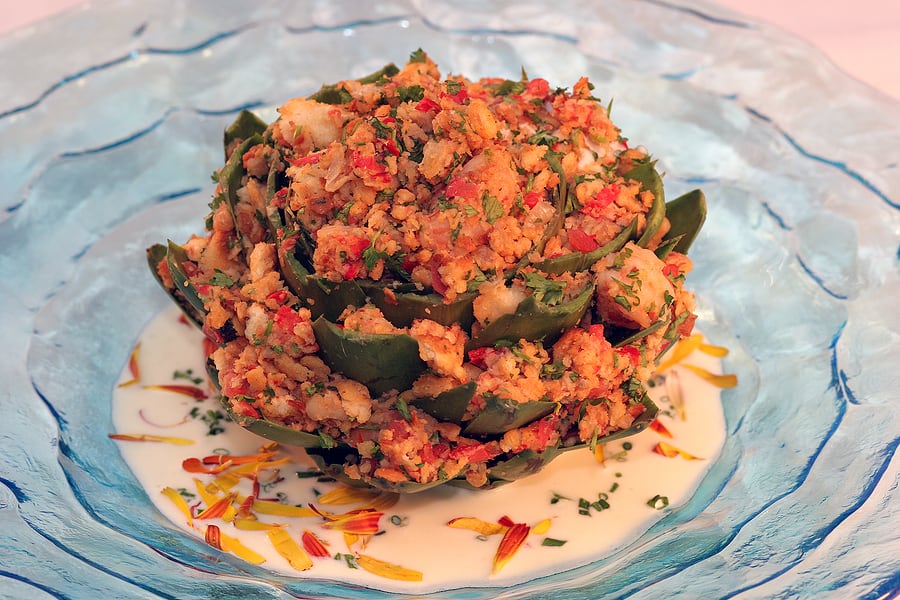
Artichokes are always eaten cooked. Once cooked, they can be served hot, warm or cold. Pull off each leaf; dunk it in the sauce; put it in your mouth and pull, scraping the tender flesh through your teeth. Cut the tender nut-flavored bottom into bite-sized pieces, dunk in sauce and eat. Serve with béchamel, butter, or hollandaise sauce.
Whole cleaned baby artichokes can be deep-fried to a golden brown.
Steaming is perhaps the best way to cook an artichoke. The flavor and nutrients will be retained.
Steaming an artichoke. Stand the artichoke in a stainless steel pot or steamer basket with 2 to 3 inches (5-7.5 cm) of salted water so that it does not completely water cook. Cover. Steam the choke until the stem end is tender–about 20 to 40 minutes. Remove the thistle-like choke and the small purple leaves. Tug on one of the leaves; if it comes off easily the artichoke is finished cooking. Stuffed artichokes are a favorite in Arabic cuisine. Stuff steamed artichokes with rice, ground meat, sausage, chicken, vegetables, cheese or combinations and bake until bubbling.
Stuffing artichokes. To stuff an artichoke, spread open the leaves and remove some of the center leaves; cut off some of the hard tips of the outer leaves. For an Italian-style stuffing, use seasoned breadcrumbs with anchovies, topped with tomato sauce.
Use baby artichokes in stews or marinated in olive oil, vinegar, and garlic as part of an antipasto.
Choosing an artichoke. Select artichokes that have crisp, tightly packed or closed leaves that are deep green in color. The leaves of a fresh artichoke will squeak when they are pressed together. An artichoke should be heavy for its size. Light feeling chokes have begun to dehydrate.
Avoid chokes that are tough, woody, or dry or that have leaves that have spread apart. If the cut end is black or the leaves have started to open, the choke is not fresh.
Size is not an indication of age when it comes to artichokes rather it is an indication of where on the plant the choke grew: the large chokes at the top and the smaller ones sprout from side stalks. The larger the artichoke, the larger the fleshy heart.
Brown streaks may a sign of age, but rather a “kiss of the frost.” Artichokes will be more intensely nutty-flavored after a frost.
Artichoke articles on Harvest to Table:
How to Plant and Grow Artichokes
How to Cook and Serve Artichokes
Artichokes and Mint Side Salad
Artichokes Steamed and Stuffed
Three Artichoke Dipping Sauces
Artichoke Growing Problems Troubleshooting
How to Plant and Grow Jerusalem Artichokes – Sunchokes
Jerusalem Artichoke – Sunchoke Plant Starting Tips
How to Harvest and Store Jerusalem Artichokes – Sunchokes
Five Ways to Cook and Serve Jerusalem Artichokes – Sunchokes















